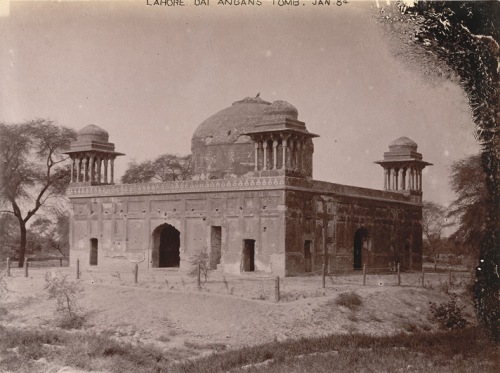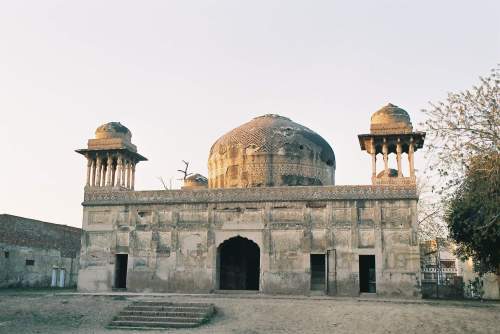Recent picture of Dai Angah’s tomb.
Mubarak Haveli located in old Lahore. This piece was written in response to the information found on this blog. I am publishing this ‘correction’ of facts for the readers. No wonder there is not a single history but several narratives of the past. • During the rule of Muhammad Shah, three amirs namely Bahadur Ali, Nadir Ali, and Babur Ali constructed a haveli in Mochi Gate area. Coinciding with its completion Bahadur Ali was blessed with a son and thus the haveli was named Mubarak Haveli. Prince Shah Shuja ul-Mulk was made to stay at this haveli by Ranjeet Singh, who later forced the prince to surrender Koh-i-Noor to him.
• On Safar 20, a chehlum procession – forty days after Hazrat Imam Hussain’s (RA) martyrdom – makes its way from Haveli Alif Shaheeyan in Mochi Gate, ending at Karbala Gamay Shah. The mourning ends on the 8th of Rabiul Awal with a procession that originates from an imambargah in Islampura, concluding at Karbala Gamay Shah. Another procession to commemorate the martyrdom of Hazrat Imam Ali (RA) on the 21st of Ramadan, which starts from Mubarak Haveli, also concludes at Karbala Gamay Shah, making it the final destination of all mourning processions in the city.
• In Lahore, the traditional Tazia Alam procession was held from Mubarak Haveli inside Mochi Gate early in the morning and it culminated at Karbala Gamay Shah in the evening after passing through its traditional route. The route of the procession included Imambargah Ghulam Ali Shah, Chowk Nawab Sahab, Mochi Gate, Lal Khoo, Fazal Haveli, Takia Nathay Shah, Koocha Shian, Chuhatta Mufti Baqar, Old Kotwali, Kashmiri Bazaar, Dabbi Bazaar, Sunehri Masjid, Paniwala Talab, Chowk Nogaza, Chowk Tarannum Cinema, Chowk Tibbi, Bazaar Hakeeman, Chowk Novelty, Mohalla Jogian, Oonchi Masjid and Bhaati Gate.
• On the immediate right of the gate, there exists Mochi Bagh which is one of the major places for political get together in Lahore. Many political, processions and gatherings take place here. Dried fruit markets, kites shops and that of fireworks are the splendor of this historical gate. Fazal Sweet House is the famous sweet shop of the area. Besides, Kabab of this particular gate are also unbeatable. The gate is also a prominent roadway for some reputed Havelis of the Mughal Empire. They include Mubarak Haveli, Nisar Haveli and Laal Haveli etcetera. A number of Imam Bargahs (sacred place of Shia sect) are also located in different Havelis. A big mourning procession appears from Nisar Haveli every year on 10th of Moharam. “Das Kulcha with Lonchara” is the mouthwatering breakfast prepared inside the gate from decades.
• According to a legend it is named after Moti, a guard of the gate during the Mughal era, who guarded and looked after the gate all his life. The most likely origin of its name, however, seems to be from the word Morchi, which means trench soldier. The Governor’s “Piada” units were stationed here during the pre-Mughal dynasty rule. This is further borne by the fact that the different streets (Mohalla’s) which still bear their old names are the Mohalla Teer-garan (arrow craftsmen), Mohalla Kaman-garan (bow craftsmen). The bazaar around the Mochi gate is renowned for its shops of Dried fruit, kites and fireworks Further inside is the Mohalla Shia, where the traditional Shia (Islamic sect)of Lahore still gather annually, at Moharram (first lunar month of the Islamic calendar) to carry out the Majaalis (Shia religious gatherings) and Maatum (self chest beating)to commemorate the martyrdom of Imam Hussain, the grandson of the Islamic prophet Muhammad. A number of Imaam Bargahs in the form of Haveli’s are situated here. Apart from their religious significance, some are a masterpiece depicting the architecture of their times. Mubarak Haveli, Nisar Haveli and Laal Haveli are, but a few examples. A Kebab Shop, a sweet mart and an Old Khoo (water well) are some of the well known features of Mohalla Shia.In front of the Laal Haveli is the Mochi Baagh. This, until recently, was a lush green patch with shady trees, it is barren now due to its landscaping to become a “speaker’s corner” in the light of its history of it having numerous renowned political leaders addressing the crowds at this place.




No comments:
Post a Comment